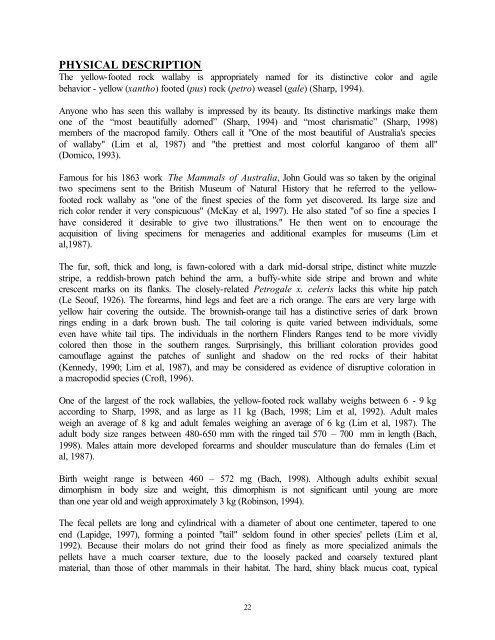Yellow-footed Rock Wallaby Husbandry Manual - Marsupial and ...
Yellow-footed Rock Wallaby Husbandry Manual - Marsupial and ...
Yellow-footed Rock Wallaby Husbandry Manual - Marsupial and ...
Create successful ePaper yourself
Turn your PDF publications into a flip-book with our unique Google optimized e-Paper software.
PHYSICAL DESCRIPTION<br />
The yellow-<strong>footed</strong> rock wallaby is appropriately named for its distinctive color <strong>and</strong> agile<br />
behavior - yellow (xantho) <strong>footed</strong> (pus) rock (petro) weasel (gale) (Sharp, 1994).<br />
Anyone who has seen this wallaby is impressed by its beauty. Its distinctive markings make them<br />
one of the “most beautifully adorned” (Sharp, 1994) <strong>and</strong> “most charismatic” (Sharp, 1998)<br />
members of the macropod family. Others call it "One of the most beautiful of Australia's species<br />
of wallaby" (Lim et al, 1987) <strong>and</strong> "the prettiest <strong>and</strong> most colorful kangaroo of them all"<br />
(Domico, 1993).<br />
Famous for his 1863 work The Mammals of Australia, John Gould was so taken by the original<br />
two specimens sent to the British Museum of Natural History that he referred to the yellow<strong>footed</strong><br />
rock wallaby as "one of the finest species of the form yet discovered. Its large size <strong>and</strong><br />
rich color render it very conspicuous" (McKay et al, 1997). He also stated "of so fine a species I<br />
have considered it desirable to give two illustrations." He then went on to encourage the<br />
acquisition of living specimens for menageries <strong>and</strong> additional examples for museums (Lim et<br />
al,1987).<br />
The fur, soft, thick <strong>and</strong> long, is fawn-colored with a dark mid-dorsal stripe, distinct white muzzle<br />
stripe, a reddish-brown patch behind the arm, a buffy-white side stripe <strong>and</strong> brown <strong>and</strong> white<br />
crescent marks on its flanks. The closely-related Petrogale x. celeris lacks this white hip patch<br />
(Le Seouf, 1926). The forearms, hind legs <strong>and</strong> feet are a rich orange. The ears are very large with<br />
yellow hair covering the outside. The brownish-orange tail has a distinctive series of dark brown<br />
rings ending in a dark brown bush. The tail coloring is quite varied between individuals, some<br />
even have white tail tips. The individuals in the northern Flinders Ranges tend to be more vividly<br />
colored then those in the southern ranges. Surprisingly, this brilliant coloration provides good<br />
camouflage against the patches of sunlight <strong>and</strong> shadow on the red rocks of their habitat<br />
(Kennedy, 1990; Lim et al, 1987), <strong>and</strong> may be considered as evidence of disruptive coloration in<br />
a macropodid species (Croft, 1996).<br />
One of the largest of the rock wallabies, the yellow-<strong>footed</strong> rock wallaby weighs between 6 - 9 kg<br />
according to Sharp, 1998, <strong>and</strong> as large as 11 kg (Bach, 1998; Lim et al, 1992). Adult males<br />
weigh an average of 8 kg <strong>and</strong> adult females weighing an average of 6 kg (Lim et al, 1987). The<br />
adult body size ranges between 480-650 mm with the ringed tail 570 – 700 mm in length (Bach,<br />
1998). Males attain more developed forearms <strong>and</strong> shoulder musculature than do females (Lim et<br />
al, 1987).<br />
Birth weight range is between 460 – 572 mg (Bach, 1998). Although adults exhibit sexual<br />
dimorphism in body size <strong>and</strong> weight, this dimorphism is not significant until young are more<br />
than one year old <strong>and</strong> weigh approximately 3 kg (Robinson, 1994).<br />
The fecal pellets are long <strong>and</strong> cylindrical with a diameter of about one centimeter, tapered to one<br />
end (Lapidge, 1997), forming a pointed "tail" seldom found in other species' pellets (Lim et al,<br />
1992). Because their molars do not grind their food as finely as more specialized animals the<br />
pellets have a much coarser texture, due to the loosely packed <strong>and</strong> coarsely textured plant<br />
material, than those of other mammals in their habitat. The hard, shiny black mucus coat, typical<br />
22




